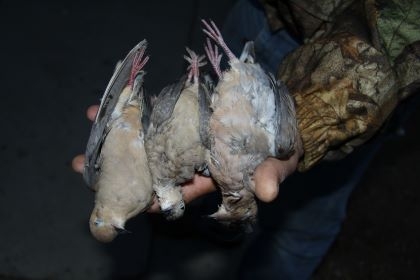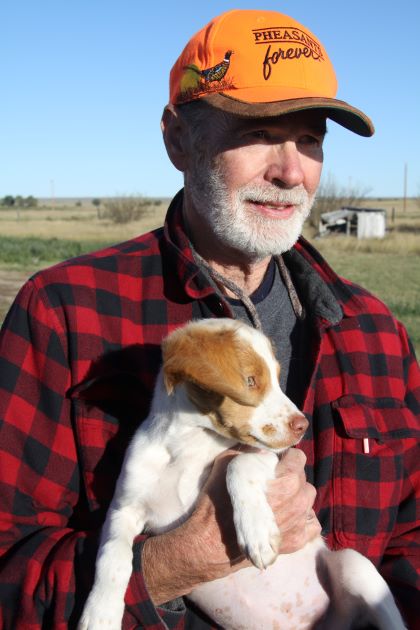Doves, Up North

Across much of the South the opening of dove season is a social gathering marked by lots of shooting, good-natured ribbing among friends and, after the shooting is done, a Southern-style barbecue complete with a cold beverage or two.
Up North, until a few decades ago, the mourning dove enjoyed “songbird” status and wasn’t hunted. Eventually sportsmen began to grumble. Why, they wondered, can’t we have a chance at a challenging game bird that will help hone our wingshooting skills?
Thanks to pressure by frustrated hunters and game departments, state legislatures began to relent. Pennsylvania, Ohio, Indiana, Nebraska, North Dakota, South Dakota, Wyoming and Montana gave their blessing to a dove season in the 1980s and 1990s, and as the new century dawned holdout states in the Midwest began to come onboard. Wisconsin became the 39th state to authorize a dove season in 2003, Minnesota the following year and Iowa in 2011. Today only a handful of states, mostly in the Northeast, do not consider the mourning dove a game bird.
 A handful of doves.
A handful of doves.Because doves begin to migrate south in late summer, hunters in northern states have a limited window of opportunity. An early cold snap in states like Montana, North Dakota and Minnesota can send doves winging south before a shot is fired. “Here today, gone tomorrow” is a common lament in eastern Montana where my friends and I hunt each fall.
The federal government sets the framework for migratory bird seasons (doves are migratory but considered upland game birds) and states must follow the general guidelines set by the U.S. Fish and Wildlife Service. Opening date varies by state but Montana’s September 1st opener is the earliest allowed by the federal government.
Late August finds me watching weather forecasts and checking with my farmer friend, Jon, to get a feel for hunting prospects. After phone-call pleasantries regarding families and crops, I get down to business: “Whatcha seeing for doves?”
“Plenty of `em,” says Jon. “Starting to gang up though, fixin’ to move before too long. Opener should be good if the weather holds.”
So the last week in August my hunting partner and I pack our trailers for the long trek to eastern Montana. There are doves in western Montana as well, but not in the numbers we see in the eastern part of the state. Not far from the North Dakota line we turn north toward the Canadian border. It is wheat country, interspersed these days with pulse crops like peas and lentils as well as canola, flax, alfalfa, soybeans and hemp. Hot damn, we’re seeing lots of doves.
 The author with Tess.
The author with Tess.When we get to our friend Jon’s place he is toiling under a bright blue sky in his air-conditioned, computerized green-and-yellow John Deere combine, cutting straight lines out in the golden wheat. He’ll be glad to see us since my hunting partner, Joe, knows how to drive a wheat truck and can help with harvest. I know little about farming so I’m a gopher – spelled gofer. I help move vehicles, ferry cold drinks and sandwiches out to the combine, feed the barn cats, and in my spare time, scout for doves.
The dogs all know the drill, they’ve done it since they were pups. It’s heaven on earth for city dogs out on the ranch: barn cats to harass, pheasants in the shelterbelts, farm dogs to get reacquainted with, a thousand new scents to explore. As the days tick down toward September 1st, we watch the weather, keeping our fingers crossed. Dove numbers are thinning every day, but there are still enough. Was it three years ago a cold front stormed in from Canada and left us doveless on the opener?
My black Lab, Bailey, and Joe’s springer spaniel, Alfie, get the nod for opening morning. We’ll hold our two Brittanys in reserve for an afternoon hunt if we haven’t filled our limits. This year the weather gods have smiled and the dove numbers have held, with no storms or cold weather in the forecast.
Suddenly it’s opening morning and we’re up early to air the dogs, load vests with shotgun shells, drink coffee, and munch cinnamon rolls with Jon. He’ll hunt with us this morning since he can’t start combining until the wheat dries a bit from last night’s heavy dew.
 Bailey
BaileyNo use starting at the crack of dawn, though. The doves are in the fields filling their crops with wheat and weed seeds. But they’ll soon be moving back toward water and the trees that line the quarter-mile lane from the county road to where we’re camped at Jon’s outbuildings.
I head for my favorite spot at the end of a shelterbelt near Jon’s corrals. Joe sets up a few hundred yards away near an old brush pile bordered by a wheat field. Jon will move around a bit, keeping an eye out for prevailing flight patterns.
You don’t need a lot of specialized equipment to hunt doves. I wear a camo hat and shirt or jacket and set up with trees or brush behind me to break my outline. You’ll want a stool or chair to sit on. A few dove decoys fastened to a dead tree branch can help. A shotgun choked improved cylinder or modified works fine; I use standard trap loads with No. 7½ or No. 8 shot.
I’m ready now, looking west into an empty sky painted Charlie Russell blue, wondering if the doves have headed south during the night. The sun is an orange ball behind me in the east, the air cool and filled with the pleasant scent of mowed hay. I hear Joe’s shotgun bark and a moment later hear him call “Fetch!” to Alfie. Then I hear two reports from Jon off in the distance.
 The harvest of a successful dove hunt.
The harvest of a successful dove hunt.What makes doves such tricky targets? For one thing, they can move right along; they’ve been clocked at speeds of more than 55 miles per hour. A five-ounce dove is a small target and shooting at birds too far away is a sure-fire way to burn through a box of shells without much to show for it. Speaking of shells, you might want to have two or three boxes, since most dove hunters will need more than a box to bag a Montana limit of 15 doves. The nationwide average is one dove harvested per four shots fired, but many hunters won’t do that well. When dove season opens across America, ammo company executives grin like Cheshire cats.
Then there is the dove’s erratic flight pattern. They can perform aerial acrobatics in the blink of an eye, and they often zig when you zag. The wind is another complicating factor, and it often blows out on the prairie. When it really gets to woofing doves can seem nearly impossible to hit, especially downwind birds that zip past like feathered rockets.
A dog is a great help in finding and retrieving birds that fall in tall grass or weedy cover. The dove’s gray and buff colors blend into the background, making downed birds hard to spot. My dogs love doves and it’s a great tune-up for grouse, pheasants and ducks later in the fall. Just make sure you bring enough water because you and your dog will get hot and thirsty as the day warms up.
 Doves have meat that is dark and delicious, and best shared with friends and family.
Doves have meat that is dark and delicious, and best shared with friends and family.Like all birds that fly long distances, doves have meat that is dark and delicious. For me, three doves are enough for a meal but hungry hunters might want another bird or two. I like to marinate the breasts in Italian dressing, then put them on the grill and cook them medium-rare. Overcooking dries them out and makes them less tasty.
A couple of Jon’s friends and neighbors showed up later in the day to try their hand at dove shooting, and that evening found our congenial group gathered around a table set with corn on the cob, potato salad and baked beans. Cold drinks in hand, we rehashed the day’s events and traded barbs about hits and misses while doves sizzled on the grill.
We all agreed that southerners have a good thing going with their time-honored dove hunting tradition. Up north we may still have a few things to learn, but we’re getting there. If you live in a northern state and have never hunted mourning doves, give it a try – you’ll be glad you did.


Comments